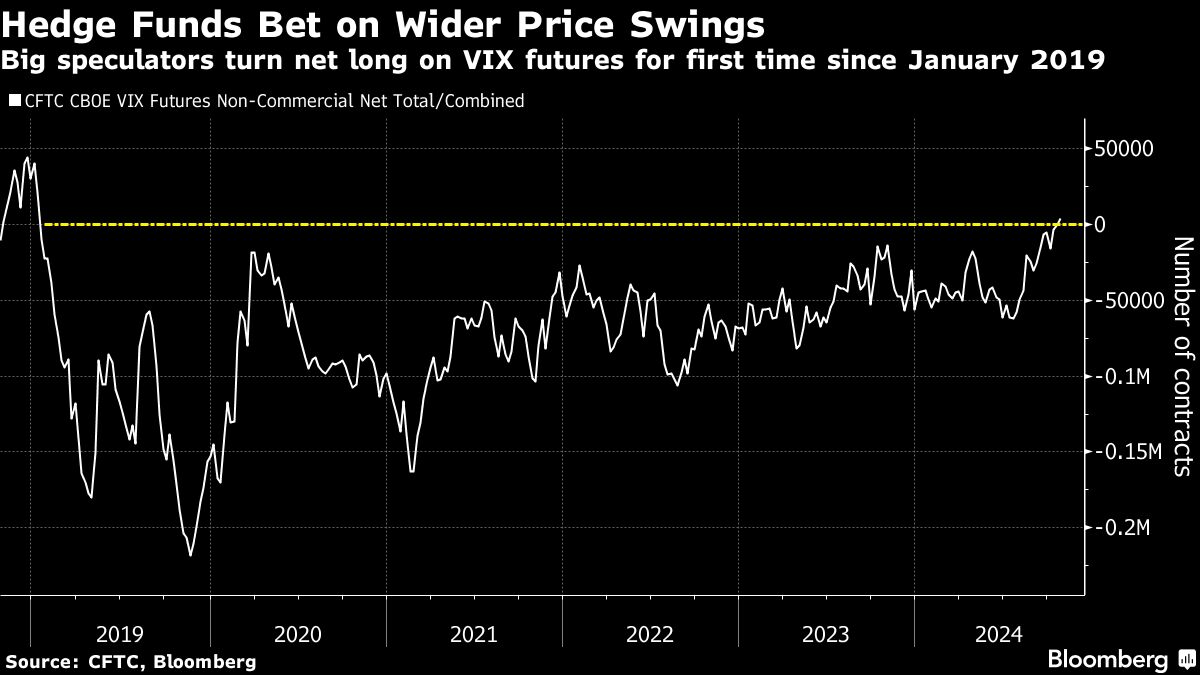
(Bloomberg) — One trading session left. That’s all Wall Street has before Tuesday as US voters choose their next president, potentially determining the direction of the economy for the next four years.
Most Read from Bloomberg
Traders are buzzing about the possibilities, constantly checking the latest polls and moves in election betting markets to divine who’s ahead, Republican Donald Trump or Democrat Kamala Harris, and what that means for their positions. In some corners, speculation is that Wall Street is betting on Trump. But when it comes to actually putting down money in the stock market based on that, things are quiet.
Investing pros know there’s a windfall to be made in calling the winner before it happens. Trouble is, this election is far too close for that, making the risk of a miss too high for many to stomach.
“We are not positioning for an outcome in the election because it is a coin flip,” Eric Diton, president and managing director of the Wealth Alliance, said in an interview. “It does not make sense to make a bet.”
Most traders see volatility coming this week, possibly lots of it with the strong likelihood of a disputed result dragging the vote count out for weeks or even months. This explains why the Cboe Volatility Index climbed above 20 in its last four sessions, a level that typically signals rising stock market stress. And it’s why investors are less eager to pick winners and losers based on who they think will be America’s next president.
“Polls have been so wrong in the past,” said Dave Lutz, equity sales trader and macro strategist at JonesTrading. “There is just no edge to see who is winning.”
Safety In Cash
The other positioning challenge is the number of additional catalysts surrounding the vote that are likely to move the market. Election Day will quickly be followed on Thursday by the Federal Reserve’s interest-rate decision and Fed Chair Jerome Powell’s press conference, where he’ll give details on the central bank’s interest-rate path. And a big chunk of US corporations are still due to report their earnings, with chip giant Nvidia Corp.’s results expected on Nov. 20.
This explains why Lutz isn’t specifically positioning for the election. What he recommends instead is “sitting on some cash” that can be deployed when any short-term opportunities open up, like individual stocks or sectors having knee-jerk reactions as a winner emerges.
“I would say many investors are positioned exactly that way,” Lutz said.
Take Robert Schein, chief investment officer at Blanke Schein Wealth Management, who said he’s boosted his cash equivalent holdings to 10% ahead of the election from his usual 5%. His strategy is to be ready to swoop in on assets when the results inevitably trigger volatility in at least some parts of the market.
“Investors need to look through lingering election risks,” Anwiti Bahuguna, chief investment officer of global asset allocation at Northern Trust Asset Management, said in an interview. “Traders can’t even position at this point since it’s so speculative, and traders don’t know what policy proposals would actually get passed from either candidate through Congress.”
Perhaps not surprisingly, markets look jittery. The S&P 500 is trading near its all-time high while the VIX is over 20. The last time the S&P set a record with the so-called fear gauge this high was during the outbreak of the delta variant of coronavirus in March 2021. Meanwhile, hedge funds are betting on even wider price swings. Large speculators turned net long on the VIX futures for the first time since January 2019, data compiled by the Commodity Futures Trading Commission showed earlier this month.
Options markets data show traders are staying defensive, placing above-normal valuations on protection against a rapid selloff, according to Rocky Fishman, founder of Asym 500. Part of this is being driven by the flurry of reports and data coming over the next few days, including the Fed decision, earnings and inflation numbers, he added.
“While markets are clearly pricing in a high-volatility day on Wednesday when we learn about the election results, the period around it is far from quiet,” Fishman said.
Beyond The Election
Corporate insiders also are hesitant to play the stock market. Just 261 corporate executives bought shares of their own firms in October, the least since at least 2017, pushing the buy-sell ratio to the second-lowest level since the spring of 2021, data compiled by the Washington Service show.
Investors looking for a safer equities play should instead look past the election noise, according to some Wall Street pros.
“The election is such a low probability event, so we fully expect a volatile period over the next month,” Northern Trust’s Bahuguna said. “But ultimately what’s underpinning the stock market is decent corporate earnings, strong economic growth, inflation coming down and the Fed cutting rates.”
Northern Trust is overweight US equities based on resilient economic strength, and it’s underweight bonds to hedge against inflation risks. The firm is also overweight real assets, including infrastructure, natural resources and real estate, to shield portfolios from future turbulence if the labor market remains tight and economic growth stays sturdy.
Others are looking at corporate earnings, particularly higher quality balance sheets as rates remain elevated with the Fed just beginning to cut.
“Interest rates are still restrictive and increasing volatility is more likely through the end of the year, so a more conservative approach is appropriate,” said Brian Mulberry, client portfolio manager at Zacks Investment Management.
The point in all of this is, with an election that doesn’t have an obvious favorite, the safest play for investors is patience. That’s what Wall Street is preaching — at least for now.
“If it was a cleaner call, it would be baked into the market and there would be little left to exploit,” said Mark Luschini, chief investment strategist at Janney Montgomery Scott. “But in something this tight it is better to look over the horizon and maintain your thoughts on what the macroeconomic condition will look like six to 18 months from now, rather than just on the outcome on that day.”
–With assistance from Natalia Kniazhevich and Alexandra Semenova.
Most Read from Bloomberg Businessweek
©2024 Bloomberg L.P.
EMEA Tribune is not involved in this news article, it is taken from our partners and or from the News Agencies. Copyright and Credit go to the News Agencies, email news@emeatribune.com Follow our WhatsApp verified Channel




